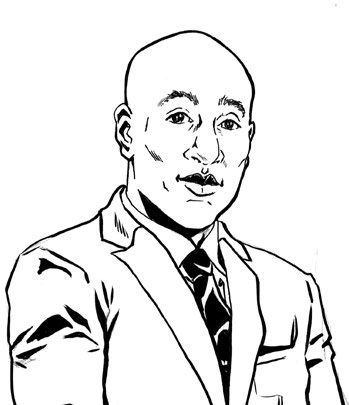ANDRAY DOMISE OPINION
FROM APRIL 2018 ISSUE OF WEST END PHOENIX
ILLUSTRATION BY
Frank Fiorentino
Donations for basketball court upgrades make a nice photo op, Andray Domise reports, but when it comes to giving at-risk youth better opportunities, sports are not enough
Everybody has a Drake story. In a city like Toronto, whose Black demographic constitutes a single-digit percentage of its population, the globally known rapper is never farther than a friend-of-a-friend in any conversation about Toronto’s rapidly burgeoning hip-hop scene. Chezlie Alexander, a former community of officer with Toronto Public Health, makes sure to get his story out of the way early. A youth known to him in the neighbourhood, lagging behind in school but in possession of a gift for beat-making, was introduced to Drake in the post-Degrassi years. Over a discussion of music and video games, the two hit it off, and the young man would go on to become a part of Drake’s OVO crew. “Drake has a real genuine heart,” Alexander tells me. “But I don’t think he fully understands the power he has in this city.”
I reached out to Alexander to discuss the Welcome Toronto program, through which Drake’s joint donation with the Toronto Raptors will see $1 million go toward refurbishing basketball courts in the city, and another $2 million going to Basketball Canada. In Rexdale, the north Etobicoke community where Alexander and I grew up, sports organizations and charities of all stripes often come knocking when there’s good work to be done. Last year the Toronto Argos picked the recently defunct Don Bosco Catholic Secondary School on Islington Avenue as its practice field, pledging investments to refurbish the site if a long-term lease can be secured. P.K. Subban, a Rexdale native, used to come around during the off-season, occasionally partnering up with local businesses (the dealership mogul and Raptors superfan Nav Bhatia, for one) to invest in hockey programs.
The event that stands out in most people’s memories, though, occurred 15 years ago, in the summer of 2003. Raptors legend Vince Carter arrived with cameras in tow, to open a $130,000 community basketball court by the Dixon towers, at Kipling. “We’re not really here to create NBA superstars or anything,” Carter said in an interview at the time, “but...giving them some place to play where they can stay out of trouble, and [not] think of crime first.” The court was a boon to the neighbourhood; before it opened, pickup ball games at the closest community centres required a driver’s licence or bus fare. But the court also attracted police attention, and young people intending to spend a summer afternoon at the ball court often wound up getting stopped, questioned and frisked by police instead.
“It’s an easy way to spend money on one project, and to say you’re doing something,” Alexander tells me. “If I had $500,000 to do something at Kipling and Dixon, I’m not building a basketball court. Not when you look at EQAO scores for that community, and only 50 per cent of grade three kids are reading at level.”
When I spoke with Abdi Warsame, a youth mentor in Rexdale’s Somali community, his feelings were no different. “To me, it’s useless,” he said. “If they want our young people to be involved with basketball, they could come up with a better mechanism. Why do they have to play basketball? Why can’t they be educated so they can work one day in the Raptors head office?”
When contacted for a response to these concerns, MLSE declined to comment.
Both Warsame and Alexander were quick to point out the example of LeBron James, as famous off the court for his charitable donations as he is for his playoff dominance. Though James does host a skills academy to help develop young players, the bulk of his charity efforts have gone towards primary and post-secondary education. In 2015, the LeBron James Family Foundation partnered with the University of Akron to launch a $41 million scholarship program, with the intention of sending 1,100 kids to college.
James has been vocal throughout his career as an advocate for higher education, especially in creating opportunities for at-risk youth. But he has also criticized the NCAA system as “corrupt,” for denying compensation and opportunities to student athletes. Barely more than 2 per cent of American high school students qualify for Division 1 college basketball programs (to say nothing of Canadian players). From that pool, only 1 per cent of NCAA players are drafted on an annual basis. “If you really think about it,” said Warsame, “basketball courts are a dead end.”
In a season when the Toronto Raptors finally have the bench depth and the team drive to make it to the NBA finals, and Drake’s “God’s Plan” video helped push rap culture’s emerging pay-it-forward ethos, the Welcome Toronto donation announcement certainly seems fortuitous. Basketball courts make for good photo opportunities, and basketball development programs make for community goodwill. But once the cameras have gone and the courts close for the night, test scores and educational opportunities in many of Toronto’s priority neighbourhoods continue to worsen. Educational achievement is, perhaps, a fitting place to begin the next chapter of Drake stories.

